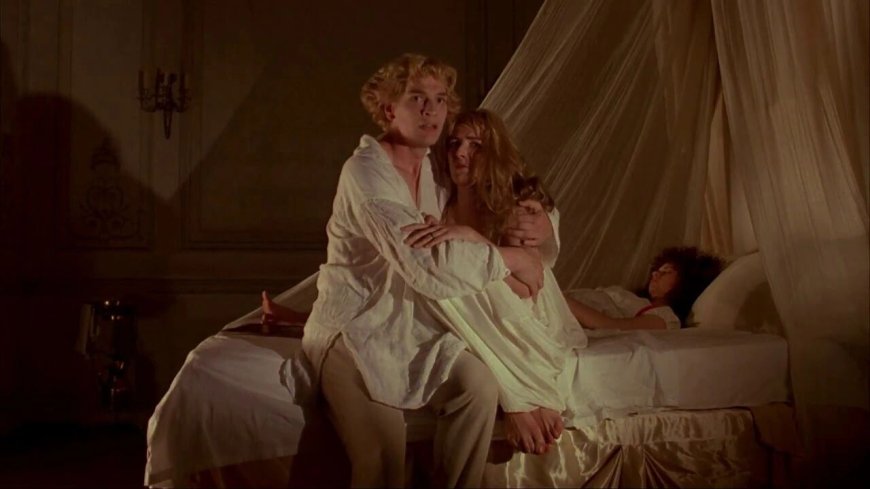Mary Shelley’s masterpiece was inspired by some truly freaky polycule action
Mary Shelley, the ultimate chaotic poly bisexual?


The famous story goes that rather than endure a threesome with her husband, the bisexual poet Percy Bysshe Shelley and his friend, the bisexual poet Lord Byron, Mary Shelley decided to invent science fiction.
Considering Byron’s obnoxious reputation, that was probably a wise choice. But during that famously horny weekend in Lake Geneva, an infamous polycule was formed, and literature has never quite looked the same.
How about we take this to the next level?
Subscribe to our newsletter for a refreshing cocktail (or mocktail) of LGBTQ+ entertainment and pop culture, served up with a side of eye-candy.
Subscribe to our Newsletter today
Mary Shelley wrote Frankenstein—which is now back in the conversation thanks to Guillermo Del Toro’s ultra-gothic adaptation—and John Polidori got the inspiration for “The Vampyre” during those wild nights in the Villa Diodati, where sex, drugs, and fantastic visions couldn’t be escaped. The scene was so bisexual that Ken Russell used it as the inspiration for his hallucinatory film Gothic in 1986.
But what actually went down during that wet, wild weekend—and how much sex were these chaotic bisexuals really having? Here’s what we know.
1816 was an exceptionally miserable year, even for the already-miserable English landscape. The year before, a volcano eruption caused icy rains to fall over Europe for months, causing 1816 to be dubbed “the year without a summer.” To get away from the gloom, Mary Shelley and her then-boyfriend Percy, whom she would later marry, absconded to the Swiss villa to unwind. There, they were joined by a queer group of friends, including the bisexual Byron, the bisexual writer Polidori, and Byron’s girlfriend (also Mary’s stepsister) Claire Clairmont to smoke opium, have sex, and write future classics of the high school curriculum. Clairmont and Byron hooked up, Polidori wanted to hook up with Byron but was rebuffed, and Byron wanted to hook up with both Percy and Mary Shelley, but was rebuffed by Mary, who wrote Frankenstein instead, spurred on by Polidori’s idea of a spooky story contest.
During that fateful weekend, Mary Shelley didn’t get up to anything too spicy, despite these offers. Reeling from a recent miscarriage, she wasn’t in a mindset to enjoy the festivities. But a few years later, her bisexuality would enter the chat after she and Shelley had married and moved to Italy. There, in 1821, they met a couple who would pique the sexual interest of both Mary and Percy. These were Jane and Edward Williams, whose illicit relationship was similar enough to Mary and Percy’s that the couples ended up becoming great friends, with seemingly both Mary and Percy falling in love with Jane.
But things truly got crazy when Edward Williams and Percy Shelley took off on an Italian boat ride in 1822—and never returned. Both men died, and Mary and Jane were left to fend for themselves. Neither remarried, and they stayed in close contact for the rest of their lives. “Their own friendship grew deeper—and probably romantic as well,” a recent Vanity Fair article asserts.
“Being afraid of men, I was apt to get tousy-mousy for women,” Mary wrote later on—and you can probably guess what tousy-mousy means, but just in case, one scholar identified a similar phrase (“tuzzy-muzzy”) as slang for “vagina.”
Basically, both Mary and Percy really lived up to the chaotic bisexual stereotype, and throughout their lives together and apart, they seemed to find it fairly easy to cast off the Regency-era prudishness that plagued their contemporaries, even if it meant being forced to locate to Italy. They also liked to hang out with people like Byron and Polidori, who were just bisexually chaotic as themselves.
There’s also some compelling evidence that Mary had several lesbian and transmasc friends. When her pals Isabel Robinson and Walter Sholto Douglas, a Scottish trans man, needed a fake passport for Douglas so that the two could live legally as man and wife in Paris, Mary came through and managed to get one for them. Not only did Mary have several potential polycules throughout her life, she was clearly spending time in the gayborhood.
Even without the knowledge of Mary’s spicy exploits, Frankenstein remains one of the most compelling stories we have about humanity, transformation, and the sometimes invisible line between good and evil. We don’t know how queer Del Toro’s adaptation will be—though images of a zaddified Oscar Isaac prove that it’s queer enough for us—but any version of the ageless tale is sure to have something for the girls, gays, theys, and poly folks among us.
Related
This OG trans man fought for the right to have bottom surgery in the 1940s… and won
Earlier this year, we talked about the incredible true story of trans Scottish baronet Ewan Forbes, who fought for the right to marry his future wife Isabella, and won—all the way back in the 1940s. It’s the kind of story that almost beggars belief, until you learn a little more about how trans men found […]
Sign up for the Queerty newsletter to stay on top of the hottest stories in LGBTQ+ entertainment, politics, and culture.

 Mark
Mark 





